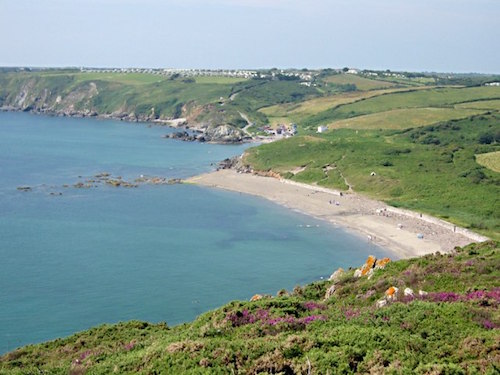Kennack Sands is a fascinating site for investigating the geology http://www.the-lizard.org/index.php/lizard-geology of The Lizard.
The Lizard
The southern part of the peninsula is a complex mix of serpentinite, schist, gabbro and granite. These rocks are over 600 million years old. The serpentine rock for which The Lizard is famous is all that remains of an ancient ocean floor, into which other igneous rocks were intruded. As the earth’s tectonic plates moved, what now forms The Lizard was welded onto continental rocks in the mid-Devonian period (roughly 385 million years ago). During the Tertiary period (from about 65 million years ago), the peninsula was submerged beneath the sea, and the subsequent erosion levelled the rocks to produce the plateau we see today. This exposed marine platform is an example of an ophiolite. Take a look at The Lizard’s geological timeline, from the very beginning of the Earth’s story until the present day.

While the plateau on the more exposed west coast has the spectacular and sheer cliffs of places such as Kynance Cove, the east-facing coastline is more sheltered, with gently inclined, wooded valleys. Kennack Sands is a very good example of this.
Kennack Sands
There are only three sand dune systems (called towans in Cornwall) on The Lizard, and one of these is at Kennack Sands (the others are at Gunwalloe and Poldhu). Kennack is also a Geological Conservation Review (GCR) site (a site of national and international importance for its geological features).
At Kennack you can see the contact between serpentine and, beneath it, Kennack gneiss. You can recognise Kennack gneiss by its pinky-brown colour and marked narrow bandings. Here, there are examples of it being intruded into dykes of serpentine and gabbro, as well as outcropping on the western beach.

Kennack Gneiss – Pat Sargeant
Here is what you can find at different locations along Kennack Sands.
Western cliffs
The outcrop of rock to your right as you come down the slipway is Kennack gneiss. Explore the cliffs to the west to find dykes of Kennack gneiss, gabbro and basalt running through the serpentine. You will also find xenoliths of serpentine in the gneiss – serpentine rocks that have been carried along as the magmatic rocks moved through the dykes.
Dyke Complex Western Cliffs – Pat Sargeant
Be careful along this section: the cliffs are not very stable and there have been occasional landslides in the past.
Western beach
This beach is sandier than its eastern neighbour. At the eastern beach you will see the old anti-tank wall, dating from the Second World War. A similar wall used to run along the western beach as well, but it was removed and this has enabled natural beach processes to begin once more, allowing the natural movement of sand and pebbles with the tides.
The Caeverracks
Look for the rich red serpentine in this headland and seaward rocks. Called bastite serpentine and veined with intersecting minerals of white and green, it was especially popular with serpentine workers and their customers.
Red Serpentine – Pat Sargeant
The Towans Kennack
Towans is one of only three sand dune systems on The Lizard. The sand here is rich in calcium carbonate, and was formed as waves and currents in the sea ground up the shells of marine creatures after they died. After being deposited on the shore, the calcareous sand is then wind-blown to form the dunes.
Eastern beach and cliffs
On the eastern beach you will see pebbles of Kennack gneiss in the company of basalt, serpentine and gabbro pebbles, as well as flints. Here you will find some of the best examples of the red (bastite) serpentine. You can also find another form of serpentine – dunite – which is lighter in colour. Beneath the eastern cliff at the end of the beach you will find a large dyke of grey basalt. At the very end of the beach, the outcrop called Green Saddle is formed of serpentine.
Kennack Stones – Pat Sargeant
The eastern beach was once part of a marshy swamp – some 4000 years ago – and the sea would have been many miles away. Keep an eye out for peat originating from this period, especially after winter storms that wash and blow away layers of sand, revealing the peat.
You can read more about the geology http://www.the-lizard.org/index.php/lizard-geology of The Lizard on this site, or pick up a copy of Beneath the Skin of The Lizard, by Robin Bates and Bill Scolding, which details seven coastal walks exploring the geology of the peninsula. We have also included a glossary [hyperlink to glossary] of geological terms.
